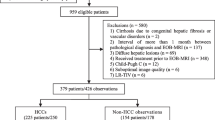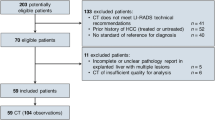Abstract
Objective
To compare diagnostic performance and agreement between CT, MRI and combined CT/MRI in reference to LI-RADS classification system to categorize hepatic observations detected in hepatic patients during screening ultrasound.
Methods
240 patients with 296 liver observations detected during ultrasound surveillance underwent hepatic CT and MRI examinations, histopathology, and clinical and radiological follow-up. Using LI-RADS v2014, six radiologists evaluated the observations independently and assigned a LI-RADS category to each observation using CT, MRI and combined CT/MRI.
Results
Combined CT and MRI in LI-RADS yielded better accuracy (91.29 %), sensitivity (90.71 %) and specificity (92.31 %) for hepatocellular carcinoma (HCC) diagnosis than using MRI or CT alone; accuracy, sensitivity and specificity decreased to 85.37 %, 86.34 %, and 83.65 %, respectively, for MRI and 67.6 %, 54.10 % and 91.35 %, respectively, for CT. The intraclass agreement of the LI-RADS scores between CT, MRI and combined CT/MRI was excellent (κ=0.9624 (95 % CI: 0.9318–0.9806)).
Conclusion
CT and MRI are complementary to each other. Combined CT/MRI enabled a more precise determination of LI-RADS category of hepatic observations; however, due to the expense and minor increase in accuracy, the combined methodology should only be utilized in cases of suspected HCC.
Key Points
• Hepatic observation may be categorized differently depending on the imaging modality used.
• We compared LI-RADS categorization between CT, MRI and combined CT/MRI.
• MRI produces higher accuracy and sensitivity, while CT produces higher specificity.
• Combining CT and MRI improves LIRADS categorization reports.
• Considering additional cost, combined methodology could be restricted to challenging cases.






Similar content being viewed by others
Abbreviations
- AUC:
-
Area under the ROC curve
- CI:
-
Confidence interval
- CT:
-
Computed tomography
- DWI:
-
Diffusion-weighted image
- HCC:
-
Hepatocellular carcinoma
- HU:
-
Hounsfield units
- LI-RADS:
-
Liver Imaging Reporting and Data System
- MDCT:
-
Multidetector computed tomography
- MRI:
-
Magnetic resonance imaging
- ROC:
-
Receiver operating characteristic
- US:
-
Ultrasound
References
Purysko AS, Remer EM, Coppa CP, Leão Filho HM, Thupili CR, Veniero JC (2012) LI-RADS: a case-based review of the new categorization of liver findings in patients with end-stage liver disease. Radiographics 32:1977–1995
Davis GL, Dempster J, Meler JD et al (2008) Hepatocellular carcinoma: management of an increasingly common problem. Proceedings (Baylor University. Medical Center) 21:266
Bruix J, Sherman M (2011) Management of hepatocellular carcinoma: an update. Hepatology 53:1020–1022
Liu D, Fong DY, Chan AC, Poon RT, Khong PL (2014) Hepatocellular carcinoma: surveillance CT schedule after hepatectomy based on risk stratification. Radiology 274:133–140
Choi JY, Lee JM, Sirlin CB (2014) CT and MR imaging diagnosis and staging of hepatocellular carcinoma: part I. Development, growth, and spread: key pathologic and imaging aspects. Radiology 272:635–654
Choi JY, Lee JM, Sirlin CB (2014) CT and MR imaging diagnosis and staging of hepatocellular carcinoma: part II. Extracellular agents, hepatobiliary agents, and ancillary imaging features. Radiology 273:30–50
Zhang YD, Zhu FP, Xu X et al (2016) Classifying CT/MR findings in patients with suspicion of hepatocellular carcinoma: Comparison of liver imaging reporting and data system and criteria-free Likert scale reporting models. J Magn Reson Imaging 43:373–383
American College of Radiology (2014). Liver Imaging-Reporting And Data System. Published March 2011. Updated 2013. Available at: http://www.acr.org. Accessed July 2014.
Mitchell DG, Bruix J, Sherman M, Sirlin CB (2015) LI-RADS (Liver Imaging Reporting and Data System): Summary, discussion, and consensus of the LI-RADS Management Working Group and future directions. Hepatology 61:1056–1065
Zhang YD, Zhu FP, Xu X et al (2016) Liver Imaging Reporting and Data System: Substantial Discordance Between CT and MR for Imaging Classification of Hepatic Nodules. Acad Radiol 23:344–352
Corwin MT, Fananapazir G, Jin M, Lamba R, Bashir MR (2016) Differences in liver imaging and reporting data system categorization between MRI and CT. Am J Roentgenol 206:307–312
American College of Radiology (2015). Liver Imaging-Reporting and Data System, version 2014-C. Available at: http://www.acr.org/QualitySafety/Resources/LIRADS/. Accessed: December 2015.
Cha, D. I., Jang, K. M., Kim, S. H., Kang, T. W., & Song, K. D. (2017). Liver Imaging Reporting and Data System on CT and gadoxetic acid-enhanced MRI with diffusion-weighted imaging. Eur Radiol 1-12
Forner A, Vilana R, Ayuso C et al (2008) Diagnosis of hepatic nodules 20 mm or smaller in cirrhosis: prospective validation of the noninvasive diagnostic criteria for hepatocellular carcinoma. Hepatology 47:97–104
Sangiovanni A, Manini MA, Iavarone M et al (2010) The diagnostic and economic impact of contrast imaging techniques in the diagnosis of small hepatocellular carcinoma in cirrhosis. Gut 59:638–644
Leoni S, Piscaglia F, Golfieri R et al (2010) The impact of vascular and nonvascular findings on the noninvasive diagnosis of small hepatocellular carcinoma based on the EASL and AASLD criteria. Am J Gastroenterol 105:599
Khalili K, Kim TK, Jang HJ et al (2011) Optimization of imaging diagnosis of 1–2cm hepatocellular carcinoma: an analysis of diagnostic performance and resource utilization. J Hepatol 54:723–728
Sersté T, Barrau V, Ozenne V et al (2012) Accuracy and disagreement of computed tomography and magnetic resonance imaging for the diagnosis of small hepatocellular carcinoma and dysplastic nodules: role of biopsy. Hepatology 55:800–806
Furlan A, Marin D, Cabassa P et al (2012) Enhancement pattern of small hepatocellular carcinoma (HCC) at contrast-enhanced US (CEUS), MDCT, and MRI: intermodality agreement and comparison of diagnostic sensitivity between 2005 and 2010 American Association for the Study of Liver Diseases (AASLD) guidelines. Eur J Radiol 81:2099–2105
Lertpipopmetha K, Tubtawee T, Piratvisuth T, Chamroonkul N (2016) Comparison between Computer Tomography and Magnetic Resonance Imaging in the Diagnosis of Small Hepatocellular Carcinoma. Asian Pac J Cancer Prev 1 17:4805–4811
Hwang J, Kim SH, Lee MW, Lee JY (2012) Small (≤ 2 cm) hepatocellular carcinoma in patients with chronic liver disease: comparison of gadoxetic acid-enhanced 3.0 T MRI and multiphasic 64-multirow detector CT. Br J Radiol 85:e314–e322
Park VY, Choi JY, Chung YE et al (2014) Dynamic enhancement pattern of HCC smaller than 3 cm in diameter on gadoxetic acid-enhanced MRI: comparison with multiphasic MDCT. Liver Int 34:1593–1602
Lin MT, Wang CC, Cheng YF et al (2016) Comprehensive Comparison of Multiple-Detector Computed Tomography and Dynamic Magnetic Resonance Imaging in the Diagnosis of Hepatocellular Carcinoma with Varying Degrees of Fibrosis. PloS one 11:e0166157
Hayashida M, Ito K, Fujita T, Shimizu A, Sasaki K, Tanabe M, Matsunaga N (2008) Small hepatocellular carcinomas in cirrhosis: differences in contrast enhancement effects between helical CT and MR imaging during multiphasic dynamic imaging. Magn Reson Imaging 26:65–71
Honda H, Onitsuka H, Murakami J et al (1992) Characteristic findings of hepatocellular carcinoma: an evaluation with comparative study of US, CT, and MRI. Abdom Imaging 17:245–249
Pitton MB, Kloeckner R, Herber S, Otto G, Kreitner KF, Dueber C (2009) MRI versus 64-row MDCT for diagnosis of hepatocellular carcinoma. World J Gastroenterol: WJG 15:6044
Kim YK, Kim CS, Chung YE et al (2006) Comparison of gadobenate dimeglumine-enhanced dynamic MRI and 16-MDCT for the detection of hepatocellular carcinoma. Am J Roentgenol 186:149–157
An C, Rakhmonova G, Choi JY, Kim MJ (2016) Liver imaging reporting and data system (LI-RADS) version 2014: understanding and application of the diagnostic algorithm. Clin Mol Hepatol 22:296
Acknowledgements
The authors thank Prof. Khalid Lakouz, Prof. Ahmad Sabry and Dr. Mohammad Hisham for their assistance with the medical illustrations and image preparation. In addition, they express great gratitude to all staff members and colleagues in Radiology department-Zagazig University for their helpful cooperation.
Funding
The authors state that this work has not received any funding.
Author information
Authors and Affiliations
Corresponding author
Ethics declarations
Guarantor
The scientific guarantor of this publication is Mohammad Abd Alkhalik Basha, Radiology Department, Zagazig University, Egypt.
Conflict of interest
The authors of this manuscript declare no relevant conflicts of interest and no relationships with any companies whose products or services may be related to the subject matter of the article.
Statistics and biometry
The corresponding author has great statistical expertise
Ethical approval
Institutional review boards approval was obtained.
Informed consent
Written informed consent was obtained from all patients.
Methodology
• Prospective.
• Diagnostic or prognostic study.
• Performed at multiple centres.
Electronic supplementary material
ESM 1
(DOCX 20 kb)
Rights and permissions
About this article
Cite this article
Basha, M.A.A., AlAzzazy, M.Z., Ahmed, A.F. et al. Does a combined CT and MRI protocol enhance the diagnostic efficacy of LI-RADS in the categorization of hepatic observations? A prospective comparative study. Eur Radiol 28, 2592–2603 (2018). https://doi.org/10.1007/s00330-017-5232-y
Received:
Revised:
Accepted:
Published:
Issue Date:
DOI: https://doi.org/10.1007/s00330-017-5232-y




